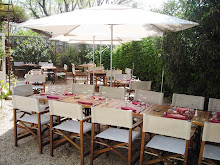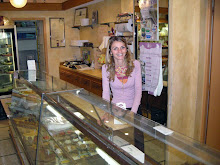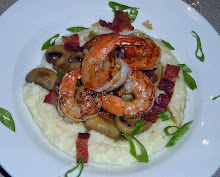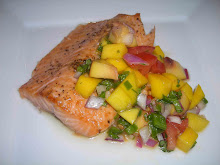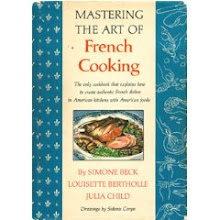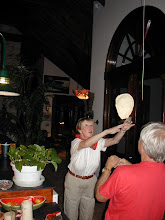When you think of Coq au Vin, you typically think of it being cooked in red wine. Here we’ve substituted a dry white wine for the red, which produced a brighter flavored dish.
This recipe is based on one from Williams Sonoma and the original called for chicken legs, but we’ve substituted boneless, skinless chicken thighs. The original also used baby carrots, which I had no luck finding. I used the smallest carrots available, but click here to see Williams Sonoma’s photo of the dish, which you’ll see is very pretty with the baby carrots and chicken legs. If at all possible, seek out smaller carrots than I found. We also substituted pearl onions (because we had them) for the shallots and used a bit less bacon than the original recipe. The pearl onions added a few more minutes, so if time is an issue, I would recommend the shallots.
Coq au Vin Blanc
Adapted slightly from Williams Sonoma – serves 4 – 6
Printable Recipe
1 bottle (750 ml) dry white wine
5 fresh flat-leaf parsley sprigs, plus 2 Tbs. finely chopped parsley
3 fresh thyme sprigs
1 bay leaf
4 oz. thick-cut bacon slices, chopped
3 1/2 lb. boneless, skinless chicken thighs
Kosher salt and freshly ground pepper
1 lb. small white button mushrooms
1 dozen (or so) pearl onions
3 tablespoons unsalted butter
3 garlic cloves, minced
2 tablespoons all-purpose flour
1/4 cup dry sherry
1 3/4 cups low salt, low fat chicken broth
3/4 lb. small baby carrots, peeled
Juice of 1/2 lemon
Preheat an oven to 350°F.
In a large saucepan over high heat, boil the wine until reduced by half, about 15 minutes.
Meanwhile, make a bouquet garni: Using a piece of kitchen twine, tie together the parsley sprigs, thyme sprigs and bay leaf. Set aside.
In a large ovenproof sauté pan or Dutch oven over medium heat, cook the bacon, stirring occasionally, until browned, about 10 minutes. Transfer to a paper towel–lined plate to drain. Discard all but 2 Tbs. of the fat from the pan. Season the chicken generously with salt and pepper. Set the pot over medium-high heat. Working in batches, sear the chicken, turning once, until browned on both sides, 8 to 10 minutes per batch. Transfer to a plate.
Discard all but 2 Tbs. of the fat from the pan. Return the pan to medium-high heat, add the mushrooms and cook, stirring occasionally, until they begin to brown, 6 to 8 minutes. Transfer the mushrooms to a bowl and set aside. Set aside the sauté pan to brown the pearl onions.
Parboil the pearl onions in boiling water for 3 seconds. Drain and when cool enough to handle, peel. Using the same sauté pan that you used to brown the mushrooms, brown the pearl onions until they are slightly brown and have taken on a bit of color. When done to your liking, set aside with the mushrooms.
Reduce the heat to medium and add the butter. When the butter has melted, add the garlic and flour and cook for 1 minute. Add the sherry and deglaze the pan, stirring to scrape up any browned bits on the pan bottom. Whisk in the reduced wine and the broth, increase the heat to medium-high and bring to a simmer. Add the bacon, chicken, mushroom mixture, carrots and bouquet garni. Cover, transfer to the oven and braise until the chicken is tender, about 1 1/2 hours (less if you’re using boneless chicken).
Transfer the chicken to a plate. Using a large spoon, skim the fat from the surface of the liquid. If you don’t have enough sauce, add some more white wine to the pan. Set the pan over medium-high heat and simmer until the sauce is thickened, 12 to 15 minutes. Discard the bouquet garni. Add the lemon juice and season to taste with salt and pepper. Return the chicken to the pan. Garnish with chopped parsley and serve immediately. Serves 4 to 6 and accompany with mashed potatoes.
For better viewing, click photos to enlarge
This will be shared with Foodie Friday at Rattlebridge Farms and Miz Helen's Country Kitchen Full Plate Thursday.
Have a nice weekend and thanks for visiting
My Carolina Kitchen


























